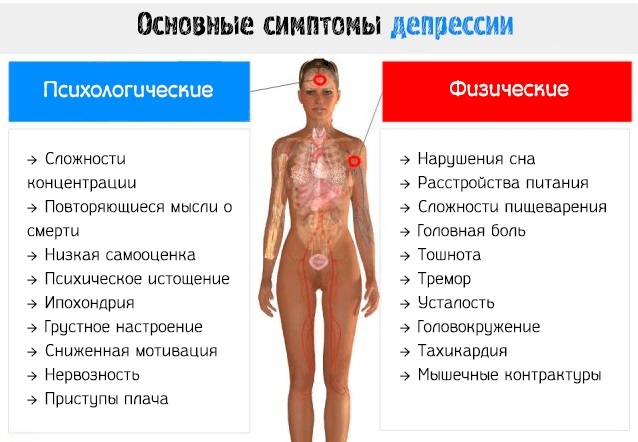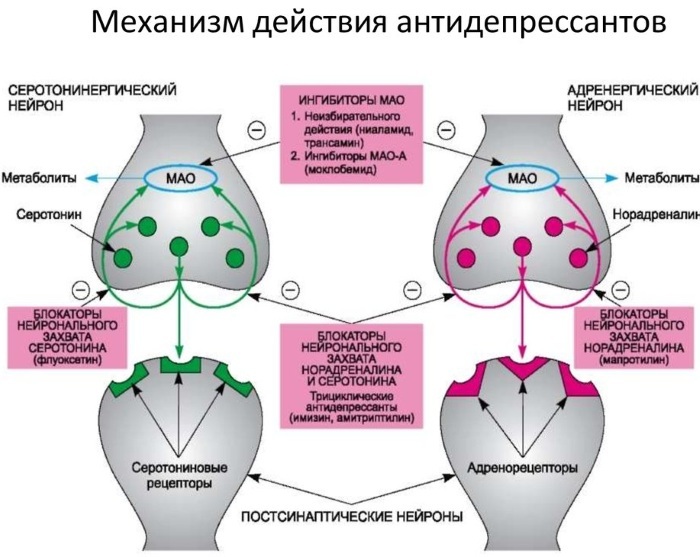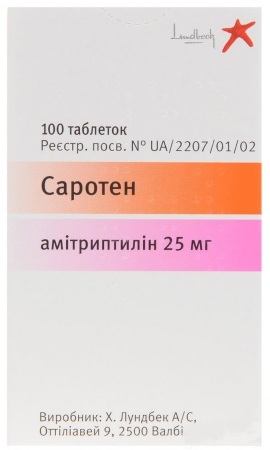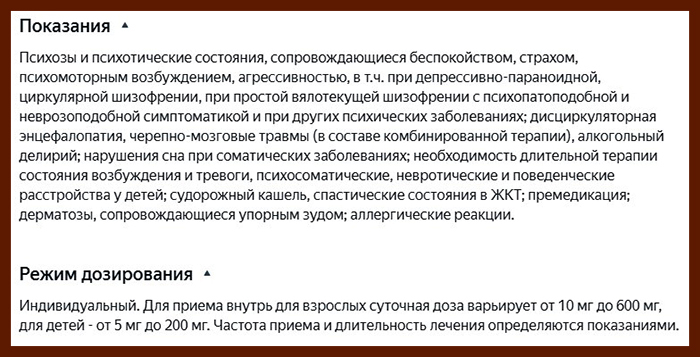Amitriptyline is one of the most affordable classic antidepressantswith a calming effect. Synthesized in the 1960s, it has become the gold standard in the treatment of depression.
Reviews of patients taking Amitriptyline throughout its existence have identified the drug as reliable and one of the the most inexpensive remedies for anxiety disorders, agitated conditions, sleep disorders, various types of depression.
Record content:
- 1 Indications for use
- 2 Compound
- 3 In what form is it produced
- 4 Pharmodynamics
- 5 Pharmacokinetics
-
6 Application
- 6.1 For children under 18
- 6.2 For adults
- 6.3 For pregnant
- 6.4 For seniors
- 7 Contraindications
- 8 Overdose
- 9 Side effects
- 10 Drug interactions
- 11 Storage conditions and periods
- 12 Conditions of dispensing from pharmacies
- 13 Analogs
- 14 Amitriptyline Recipe in Latin
- 15 Doctor reviews about the drug
Indications for use
The classic tricyclic antidepressant has a wide range of indications, primarily affecting depressive states of various nature: endogenous, neurological, involutional, reactive, caused by intake medicines. The drug is effective for organic changes in brain tissue, alcohol withdrawal syndrome.
Other indications for the appointment of Amitriptyline:
- mixed emotional disorders;
- alcoholic and schizophrenic psychoses;
- psychogenic anorexia, bulimia nervosa;
- behavioral disorders (attention and activity disorders);
- nocturnal enuresis.

Amitriptyline is prescribed for the prevention of migraine attacks, as well as for chronic pain that is difficult to relieve:
- rheumatic;
- diabetic;
- oncological;
- postherpetic;
- post-traumatic.
The drug is included in the complex therapy of stomach and intestinal ulcers, is used for cyclic vomiting syndrome, syndrome chronic fatigue and irritable bowel syndrome, as well as a number of painful pathologies of the genitourinary sphere in men and women.
Compound
The main active ingredient of the drug is amitriptyline hydrochloride - a white powder, odorless, soluble in water, ethanol, chloroform. Refers to psychopharmacological substances from the group of classic tricyclic antidepressants. Amitriptyline in the human body exhibits sedative, thymoleptic, analgesic effects.
The substance has a powerful anticholinergic effect, due to its ability to block cholinergic receptors. Sedation is due to the affinity for the H1-histamine receptors. At the same time, amitriptyline exhibits the properties of an alpha-blocker.
Additional components of the drug in tablets: cellulose (microcrystalline), talc, lactose, magnesium stearate, starch (gelatinized), silicon dioxide, quinoline dye (yellow). Auxiliary ingredients provide the shape and consistency of the tablet form of the drug and stabilize the main substance.
1 ml of amitriptyline injection solution contains 10 mg of active substance. Auxiliary ingredients of the liquid form of the drug: water, caustic soda, sodium chloride, benzethonium chloride.
In what form is it produced
Amitriptyline is available in tablets, dragees, and solution for intramuscular injection.
| Release form | Dosage | Package | Price |
| Pills | 10, 25, 50 mg | 10, 50 (less often 20, 30, 40) tablets in cell packs or polymer containers | From 18 to 57 rubles. |
| Dragee | 25 mg | In blisters of 10 and 30 pcs. | From 21 rub. |
| Solution (w / m) | 2 ml | 5 or 10 ampoules | From 43 rub. |
Amitriptyline tablets have a round, biconvex shape, film-coated, yellow colored.
Pharmodynamics
The antidepressant effect of Amitriptyline is provided by the normalization of the amount of serotonin and the retention of norepinephrine by blocking their reabsorption. Long-term use of the drug leads to a decrease in the activity of serotonin, beta-adrenergic receptors, ensures the normal transmission of nerve impulses, restores balance in the nervous system.
Amitriptyline reviews of patients taking the drug are characterized as a quick means to reduce agitation, lethargy, stop panic attacks, normalize mood and sleep. The antidepressant effect is noted within 3 weeks after the start of admission.
The blocking effect of a tricyclic antidepressant on histamine receptors provides a sedative and hypnotic effect to the drug. This property in the early stages of treatment is considered a positive quality, and with prolonged therapy is attributed to undesirable side effects.
The antiulcer effect of Amitriptyline is due to the sedative and anticholinergic effect on the gastrointestinal tract receptors.
Effectiveness in enuresis is provided by increasing the muscle tone of the sphincter and relaxation bladder (which increases its ability to stretch), as well as the muscles of the prostate glands. The analgesic effect is associated with the effect on opiate receptors and the concentration of monoamine neurotransmitters (especially serotonin) in the central nervous system.
The mechanism of action for eating disorders of a nervous nature is not fully understood, but is similar to the action for depression. The effect of amitriptyline in bulimia is noted in patients with depression and in its absence. Moreover, the correction of eating behavior and neurological symptoms can occur independently of each other.
Pharmacokinetics
Amitriptyline is highly absorbed, its bioavailability reaches 60%, and some active metabolites - 70%. The peak concentration of the active substance in the blood is reached 2–7 hours after a single dose. With intramuscular injection, the maximum concentration in the blood is higher and is achieved faster.
Amitriptyline crosses the blood-brain, histohematogenous and placental barriers, is found in breast milk in concentrations close to plasma levels. The drug metabolism takes place in the liver cells with a significant "first pass effect" and the formation of active and inactive metabolites.
The half-life of Amitriptyline can take 28 hours, but on average does not exceed 10 hours. Nortriptyline, as the most important metabolite, is found in the blood for up to 7 days. Complete elimination takes 14 days.
Application
Amitriptyline reviews of patients taking the drug are recommended to be taken strictly in accordance with instructions: without chewing, during or immediately after a meal, with a large amount of tablets liquids.
In this way, the risk of irritation of the gastric mucosa can be significantly reduced. Different conditions require different lengths of treatment. Courses shorter than 30 days are ineffective, most often antidepressant therapy lasts from several months to several years.

Before starting therapy, blood pressure is monitored. During treatment, the blood picture is monitored. Laboratory monitoring of the condition is mandatory for any fever, sore throat, flu-like condition. Long-term courses of therapy are carried out with regular monitoring of the functions of the cardiovascular system (hereinafter - CVS) and liver.
It is considered inappropriate to use the drug for more than 30 days, without a visible improvement in the condition.
For children under 18
The drug is approved for the treatment of children with some restrictions:
- the appointment is contraindicated in patients under 6 years of age;
- from enuresis for children from 6 to 10 years old, no more than 20 mg of the drug is prescribed before bedtime;
- from 10 years to 16, the amount is calculated from the ratio of 5 mg of a substance per 1 kg of weight, but not exceeding 50 mg per day;
- for violations of attention, behavior, hyperactivity, anxiety, depression, phobias in children under 12 years of age, appoint from 10 to 30 mg / day. or calculate the daily dose depending on the weight (1-5 mg / kg). Accepted fractionally up to 3 times a day;
- for adolescents, the dose of Amitriptyline is allowed to be increased to 100 mg / day.
A feature of the antidepressant effect on children with mental illness and depression is an increase in suicidal tendencies. The appointment is carried out taking into account the risk of suicide, weighing the possible harm and benefits of therapy.
For adults
The first dose of Amitriptyline for depression is performed in a small dose. In accordance with the age, weight and severity of the condition, 25 or 50 mg of the drug is prescribed once at night.
In the next 6 days, the dose is gradually raised to the prescribed dose (from 150 to 200 mg), dividing it into three doses. If there is no significant positive dynamics in 15 days, the daily rate is raised to 300 mg. Therapy is carried out unchanged until the symptoms disappear, and then the dosage is reduced.
Features of the use of Amitriptyline:
- alcohol intake is excluded for the entire period of therapy;
- rise with caution from a prone position;
- do not prescribe amitriptyline earlier than 2 weeks after taking any of the MAO inhibitors;
- with a daily dose of more than 150 mg, the likelihood of seizure activity increases;
- when long-term treatment is interrupted, a "withdrawal syndrome" occurs.
For persistent, chronic pain of any genesis, in order to prevent migraine attacks, in the treatment of stomach ulcers and the duodenum is prescribed half the dosage from 10 to 25 mg, not more than 100 mg per day, with most of the dose use before bedtime.
Acute conditions in alcohol withdrawal, psychosis in schizophrenia are stopped with a daily dose of 100 mg taken at night. The duration of further therapy is determined by the attending physician.
For pregnant
Since the active substance easily penetrates into all body fluids, the use of Amitriptyline during pregnancy is undesirable. The remedy is prescribed in extreme cases if the potential benefit significantly outweighs the possible harm to the fetus.
Amitriptyline, according to reviews of patients taking the drug during breastfeeding, causes intestinal colic, shortness of breath, excessive drowsiness, tremors and spasms in infants. Therefore, during lactation and feeding, tricyclic antidepressants are prohibited.
If there is an urgent need to take the drug during pregnancy, it is gradually excluded 6-7 weeks before the expected date of birth. Otherwise, newborns may have a “withdrawal syndrome”.
For seniors
Amitriptyline is used with caution in older patients. Elderly patients are more likely to find undesirable reactions to therapy in the form of drug psychosis and nocturnal anxiety. When the drug is discontinued, the side effects disappear on their own in a few days.
For mild violations of behavior, attention, depression in the elderly, Amitriptyline is prescribed depending on the severity of the deviation, age and concomitant diseases. The tablets are taken daily at night at a dosage of 25 to 100 mg. After achieving the effect, the daily rate is reduced to 10-50 mg.
With concomitant diseases of the CVS, during the entire therapy, it is necessary to control blood pressure, pulse, and regular ECG.
Contraindications
The drug has a powerful effect, therefore it has strict contraindications for admission and a number of relative restrictions.
Amitriptyline therapy is absolutely contraindicated in the following conditions:
- Hypersensitivity to any substance in the composition.
- Application simultaneously with MAO and 2 weeks after the end of their intake.
- Acute drug or alcohol intoxication.
- Severe forms of cardiac conduction disorders.
- Acute period of myocardial infarction.
- Glaucoma (angle-closure).
- Breastfeeding period.
- Age up to 6 years.
Since the tablets contain lactose monohydrate, the drug is prohibited from taking with galactose intolerance, impaired absorption of carbohydrates in the intestine (malabsorption), lactase deficiency.
Amitriptyline is used with caution and under constant medical supervision for such violations:
- any diseases of the CVS;
- insufficiency of hematopoiesis;
- renal / hepatic impairment;
- increased intraocular pressure;
- violation of intestinal motility and patency;
- decreased bladder tone and urinary retention;
- prostate adenoma (BPH);
- bronchial asthma;
- thyrotoxicosis;
- stroke.
Amitriptyline reviews of patients who took the drug are described as a drug that requires special control in the treatment of schizophrenia and bipolar disorder due to the possible spontaneous activation of psychosis. With epilepsy, convulsive syndrome is aggravated.
Overdose
Symptoms of exceeding individually effective doses of Amitriptyline from various organs and systems:
- CNS: hallucinations, stupor, anxiety, disorientation, muscle stiffness, pathological involuntary movements, epileptic syndrome.
- CCC: hypotension, heart rhythm disturbances, AB blockade, acute heart failure, shock, cardiac arrest.
- Others: vomiting, cyanosis of the skin, shortness of breath, hyperthermia, dilated pupils, sweating, decreased urine separation, anuria.
Symptoms appear within 4 hours of taking a high dose of antidepressant, peak within 24 hours, and may last up to 6 days. At the first sign of an overdose, urgent hospitalization is indicated.
Treatment consists of gastric lavage, intake of sorbents, and elimination of symptoms. Relief of severe conditions is performed in the intensive care unit. Hemodialysis and diuresis are ineffective. The patient's condition is monitored for at least 5 days. Relapses are possible after 48 hours, sometimes later.
Side effects
Amitriptyline reviews of patients taking the drug are described as a powerful antidepressant with a lot of unwanted side effects. The main unpleasant consequence of taking an antidepressant is called severe dry mouth., which is especially undesirable for elderly patients with problems of urination and kidney function.
Also, patients are often worried about sleepiness during the day, fatigue, emotional "deafness", disorientation, characteristic of all sedative antidepressants.
Other, more serious side effects from taking Amitriptyline appear less often, often have a dose-dependent nature, or appear with courses longer than 2 months.
Side effects of the drug:
- defocusing of vision, dilated pupils, tachycardia, delirium and hallucinations, intestinal obstruction, urinary disorders;
- fainting, irritability, mania, anxiety, tremors of various muscle groups, their twitching or paralysis, nightmares, memory impairment and inability to concentrate;
- tachycardia, "palpitations", hypotension, changes in the cardiogram in patients without heart pathologies, uncontrolled jumps in blood pressure, blockade of cardiac conduction;
- change in taste, liver malfunction, hepatitis, jaundice, nausea, heartburn, diarrhea, vomiting, uncontrolled change in appetite (increase or disappearance) associated with these effects set or weight loss;
The endocrine system can respond to the course of treatment with such manifestations: testicular edema, enlargement of the mammary glands, decreased libido or its significant increase, problems with potency.
Symptoms of abrupt discontinuation of therapy (withdrawal syndrome):
- irritability, overexcitement;
- diarrhea, vomiting, nausea;
- headaches, muscle pain;
- sleep disorders, atypical or nightmares.
Allergic side effects are: rash, swelling, itching, sensitivity of the skin and eyes to the sun. Tinnitus, swollen lymph nodes, hair loss, frequent urination, and fever are among the unusual phenomena during treatment.
Drug interactions
Joint reception of Amitriptyline with any alcohol-containing drinks depresses the central nervous system, significantly reduces pressure, and depresses the respiratory center. The body's sensitivity to alcohol increases during treatment.
The drug is absolutely incompatible with MAO inhibitor drugs, causing hyperpyrexia, uncontrolled increase in blood pressure, severe convulsions, and even death.
Interaction with drug groups and individual drugs:
- With anticholinergic drugs (antiparkinsonian, antihistamines, atropine, amantadine), the danger of all side effects increases.
- With anticholinergics (benzodiazepine, phenothiazine) - mutual enhancement of action, increased convulsive and malignant neuroleptic syndromes.
- With anticonvulsants - decreased effectiveness, depression of the central nervous system, convulsions.
- With indirect anticoagulants - increased blood thinning action.
- With cimetidine, fluoxetine and fluvoxamine, the half-life is lengthened, the risk of intoxication with amitriptyline increases (the dose should be reduced by 20-50%).
- With oral contraceptives, nicotine, barbiturates, phenytoin, carbamazepine, the plasma concentration decreases with a decrease in the effectiveness of Amitriptyline. Estrogen-containing drugs increase the bioavailability of the antidepressant.
- With acetaldehydrogenase inhibitors (for example, disulfiram) - provokes confusion to coma (delirium).
- With benatidine, guanethidine, clonidine, reserpine and methyldopa, amitriptyline reduces their hypotensive effect.
- Antiarrhythmic drugs (such as quinidine) taken together with amitriptyline have the opposite effect, disrupting the heart rhythm.
Amitriptyline reduces the effectiveness of alpha-blockers, phenytoin, and may aggravate the course of depression that occurs during treatment with glucocorticosteroids. Drugs for the treatment of thyrotoxicosis increase the risk of agranulocytosis.
The drug is incompatible with epinephrine, norepinephrine, ephedrine, phenylephrine, pimozide, probucol, thyroid hormones, causing severe arrhythmias, tachycardia, hypertensive crisis. With anticholinergics and antipsychotics, there is a risk of excessive fever (above +41.5 ° C).
Storage conditions and periods
- The drug should be stored in its original packaging in a dry, dark place. The temperature should not exceed + 25 ° С. Keep out of the reach of children.
- If stored correctly, Amitriptyline retains its medicinal properties for 3 years. After the end of this time, the drug is prohibited to use.
- The drug is available with a prescription.
Conditions of dispensing from pharmacies
The drug can only be purchased by a doctor's prescription. The prescription for the medicine remains in the pharmacy. The form, certified by a doctor, is kept for 3 months to monitor sales.
Analogs
Amitriptyline reviews of patients who took the drug are characterized as a reliable means of urgent care in acute conditions and long-term therapy of chronic pathologies. But the number of side effects and the unpredictability of individual reactions to tricyclic antidepressants often makes it necessary to choose a replacement for this available agent.
The main analogues:
- Saroten - a drug analogue of Amitriptyline according to the active substance. It is produced by foreign pharmaceutical companies and has a milder effect on the body. All indications for the appointment of Amitriptyline are valid in the case of using Saroten, but adverse reactions to it occur much less frequently. Dosages and contraindications for drugs are similar.
- Novo-tryptin (Damilen) - a structural analogue of Amitriptyline, whose action is based on the same active substance. The drug is produced in Russia and Canada. All appointments of Amitrypsin are valid for Novo-trypsin, and side effects are less pronounced. Often a remedy is prescribed for the treatment of children, elderly patients, if necessary, use during pregnancy (only from the second trimester).
- Anafranil - a substance also from the group of tricyclic antidepressants. Effective for anxiety disorders, panic attacks, depression, mental and motor retardation. The drug has much fewer contraindications: lactation period, postinfarction condition, allergy to components, age up to 5 years. The most serious side effects are tachycardia, hypertension, rash, and itching.
- Doxepin - a drug for the treatment of depression, manic-depressive psychosis, hypochondria, anxiety. It is a "lightweight version" of Amitripsilin, differing from it structurally only by one extra oxygen atom. The drug manifests itself well in the relief of panic attacks and the treatment of sleep disorders. Unlike Amitriptyline, it has a greater antihistamine activity, but less psychoanaleptic properties.
- Melipramine. The active ingredient of the drug is imipramine hydrochloride, one of the first tricyclic antidepressants. Prescribe a remedy for the same indications, including enuresis and chronic pain. The drug has a great stimulating effect, in contrast to the sedative effect of Amitriptyline, therefore it is used in the morning. In some patients, Melipramine does not cause any side effects; otherwise, the reactions of antidepressants are similar.
Amitriptyline has received positive reviews from patients who have taken the drug for many years for its fast action and availability. There are no analogues of the drug without side effects yet, therefore, despite the complex medicinal interactions and an abundance of possible unpleasant consequences, it continues to be prescribed and used with many diseases.
Amitriptyline Recipe in Latin
- Latin name: Amitriptyline (INN)
- Trade names: Amitriptyline
- Pharmacological group: Antidepressants
- Prescription form: N 107-1 / y
- Examples of recipes in Latin:
Prescription for tablet form:
Rp.: Tab. Amitriptylini 0.025
D.t.d. N 50
S. 1 tablet per night - 10 days
Recipe for a syrup shape in Latin:
Rp: Sol. Amitriptylini 1ml - 0.02
D.S: 1 ampoule 4 times a day.
The Latin recipe is for doctors, teachers, and medical students. Do not self-medicate, consult a doctor for qualified help.
WARNING! Do not self-medicate, consult a doctor for qualified help. Initial therapy in adults is 25-50mg at night, once, with dose titration to the maximum: 300mg / day in three divided doses. The drug is contraindicated in case of individual hypersensitivity, combined use with MAO inhibitors, with BPH, PUD and 12PK, GB, AMI, under the age of 6 years, women during pregnancy and breastfeeding (FDA class - C).
Doctor reviews about the drug
Doctor about Amitriptyline:



